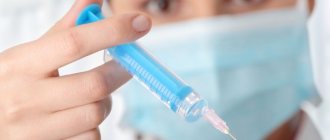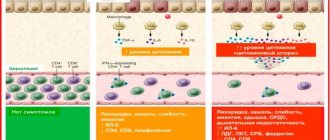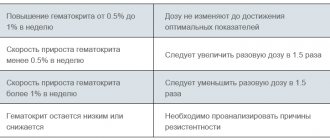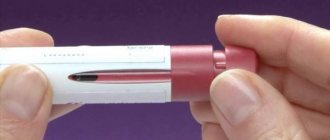Release form and composition
Humalog is produced in the form of a solution for intravenous (IV) and subcutaneous (SC) administration: colorless, transparent (in 3 ml cartridges, 5 cartridges in a blister, 1 blister in a cardboard box; in KwikPen syringe pens, in which built-in cartridges containing 3 ml of solution, 5 syringe pens in a cardboard box).
Composition of 1 ml solution:
- active substance: insulin lispro – 100 IU;
- auxiliary components: water for injection – up to 1 ml; sodium hydroxide solution 10% and (or) hydrochloric acid solution 10% – to pH 7–8; sodium hydrogen phosphate heptahydrate – 0.00188 g; zinc oxide – for Zn++ content 0.000 0197 g; metacresol – 0.00315 g; glycerin (glycerol) – 0.016 g.
Dose selection
The dosage of Humalog depends on many factors and is determined individually for each diabetic. It is not recommended to use standard regimens, as they worsen the compensation of diabetes mellitus. If the patient is following a low-carbohydrate diet, the dose of Humalog may be less than what standard means of administration can provide. In this case, it is recommended to use weaker rapid insulin.
The ultra-short-acting hormone gives the most powerful effect. When switching to Humalog, its initial dose is calculated as 40% of the previously used short-acting insulin. Based on glycemic results, the dosage is adjusted. The average need for the drug per unit of bread is 1-1.5 units.
Directions for use and dosage
The dosage of the drug is determined by the doctor individually, taking into account the concentration of glucose in the blood.
The solution is administered intravenously - if necessary, in cases of acute pathologies, ketoacidosis, in the period between operations and the postoperative period; subcutaneously - in the form of injections or prolonged infusions (via an insulin pump) into the abdomen, buttocks, thighs or shoulders, avoiding the drug entering the blood vessels. The sites of subcutaneous injections are changed each time, so that the same area is not used more than once a month. After administration, the subcutaneous injection site should not be massaged.
In each individual case, the administration regimen is set individually. Administration is carried out shortly before meals, but the drug can also be used shortly after meals.
Preparation for drug administration
Before use, the solution is checked for the presence of solid particles, cloudiness, coloring and thickening. Use only a colorless and transparent solution at room temperature.
Before the injection, wash your hands thoroughly, select and wipe the injection site. Next, the cap is removed from the needle, the skin is stretched or gathered into a large fold, the needle is inserted into it and the button is pressed. After this, the needle is removed and the injection site is gently pressed with a cotton swab for a few seconds. Using the protective cap, the needle is unscrewed and disposed of.
Before using Humalog in KwikPen syringe pens (injectors), the patient should read the instructions for use.
IV injections are carried out in accordance with normal clinical practice, for example, IV bolus administration or through infusion systems. Frequent monitoring of blood glucose concentrations is important.
The stability of infusion systems with a concentration of 0.1–1 IU per 1 ml of insulin lispro in 5% dextrose or 0.9% sodium chloride solution for 2 days is ensured when stored at room temperature.
For subcutaneous infusions, Disetronic and Minimed pumps designed for insulin infusions can be used. It is important to strictly follow the manufacturer's instructions and observe aseptic rules when connecting the system. The infusion system is changed every 2 days. During a hypoglycemic episode, the infusion is stopped until it resolves. In cases of very low blood glucose concentrations, the patient should contact their healthcare provider to consider reducing or stopping insulin infusions.
A rapid rise in blood glucose may occur if the infusion system is clogged or the pump is malfunctioning. If a disruption in insulin delivery is suspected as the cause of the increase in glucose concentration, the patient should follow the manufacturer's instructions and inform the physician (if necessary).
Humalog cannot be mixed with other insulins when using a pump.
The KwikPen insulin syringe pen contains 3 ml of a drug with an activity of 100 IU per 1 ml. 1–60 units of insulin can be administered per injection. The dose can be set with an accuracy of one unit. If too many units are set, the dose can be adjusted without losing insulin.
The injector should only be used by one patient and new needles should be used for each injection. The injector should not be used if any of its parts are damaged or broken. The patient should always carry a spare injector in case of loss or damage.
Patients with low vision or vision loss are not recommended to use the injector without the assistance of a visually impaired person trained in its use.
Before each injection, it is important to check that the expiration date on the label has not expired and that the injector contains the correct type of insulin. Therefore, it is not recommended to remove the label from it.
The color of the dose button of the QuickPen syringe pen is indicated in gray, it corresponds to the color of the stripe on its label and the type of insulin used.
Before using the injector, you need to make sure that the needle is completely attached to it. After use, the needle is removed and disposed of. The syringe pen cannot be stored with a needle attached to it, as this may cause air bubbles to form in the drug cartridge.
When a dose of a drug exceeds 60 units is prescribed, two injections are given.
To check the remaining insulin in the cartridge, point the injector with the tip of the needle up and look at the number of insulin units remaining on the scale on the transparent cartridge holder. This indicator is not used to set the dose.
To remove the cap from the injector, you need to pull it. If you have difficulty doing this, carefully rotate the cap clockwise and counterclockwise and then pull it out.
Every time before an injection, the insulin supply is checked, since without this, you can get too little or too much insulin. To check, remove the outer and inner needle caps, set 2 units by rotating the dose injection button, point the injector up and knock on the cartridge holder so that all the air collects in the upper part. Then press the dose button until it stops and the number 0 appears in the dose indicator window. While holding the button in the recessed position, slowly count to 5, at which time a stream of insulin should appear at the end of the needle. If a stream of insulin does not appear, the needle is replaced with a new one and the supply is rechecked.
Administration of the drug
- remove the cap from the syringe pen;
- wipe the rubber disc at the end of the cartridge holder with a swab moistened with alcohol;
- The needle located in the cap is placed directly along the axis onto the injector and screwed until it is completely connected;
- by rotating the dose button, set the required number of units;
- the cap is removed from the needle and it is inserted under the skin;
- press the dose button with your thumb until it stops completely. To administer a full dose, hold the button and slowly count to 5;
- the needle is removed from under the skin;
- check the dose indicator - if it shows the number 0, the dose has been administered in full;
- carefully put the outer cap on the needle and unscrew it from the injector, after which it is disposed of;
- Put a cap on the syringe pen.
If the patient doubts that he has administered the full dose, a repeat dose should not be administered.
Overdose
An overdose of the drug can cause hypoglycemia , accompanied by lethargy, sweating, vomiting , apathy , trembling, impaired consciousness, tachycardia , and headache. At the same time, hypoglycemia can occur not only in cases of drug overdose, but also be the result of increased insulin activity caused by energy expenditure or food intake. Depending on the severity of hypoglycemia, appropriate measures are taken.
special instructions
Transferring a patient to another brand or type of insulin is carried out under strict medical supervision. Changes in production method, species, type, brand and/or potency may require dosage adjustments.
Symptoms that herald the development of hypoglycemia may be less pronounced and nonspecific with intensive treatment with insulin, long-term diabetes mellitus, diseases of the nervous system associated with diabetes mellitus, and simultaneous therapy with drugs, for example, beta-blockers.
Early symptoms of hypoglycemia in patients with hypoglycemic reactions after switching from animal insulin to human insulin may be less severe or different from those they had during therapy with the previous insulin.
In cases of uncorrected hyperglycemic or hypoglycemic reactions, loss of consciousness, coma or death may occur. Using the drug in inadequate doses or discontinuing therapy, especially in type I diabetes mellitus, can lead to the development of hyperglycemia and diabetic ketoacidosis, which are potentially life-threatening for the patient.
In case of renal and liver failure, it can reduce the need for insulin, which is associated with a decrease in insulin metabolism and gluconeogenesis processes. With chronic liver failure (due to increased insulin resistance), emotional stress, infectious diseases, and an increase in the amount of carbohydrates in food, the need for insulin may increase.
In cases of changes in the usual diet and increased physical activity, the dose of the drug may need to be adjusted. Exercising immediately after eating may increase the risk of hypoglycemia. Due to the pharmacodynamics of rapid-acting human insulin analogues, hypoglycemia may develop earlier after injection than with soluble human insulin.
When prescribing an insulin drug with a concentration of 40 IU in 1 ml in a vial, you cannot collect insulin from a cartridge with an insulin concentration of 100 IU in 1 ml using a syringe for administering insulin with a concentration of 40 IU in 1 ml.
Simultaneous therapy with insulin preparations and thiazolidinedione drugs increases the risk of developing edema and chronic heart failure, especially against the background of pathologies of the cardiovascular system and in the presence of risk factors for chronic heart failure.
During therapy, patients should be careful when driving vehicles and conducting potentially dangerous activities that require increased attention and speed of psychomotor reactions.
Side effects of Humalog
Possible allergic reactions, reactions at the injection site, lipodystrophy, itching, rash, hypoglycemia. Hypoglycemia is the most common side effect of insulin therapy in patients with diabetes. Severe hypoglycemia can lead to loss of consciousness and, in exceptional cases, death. Patients may develop allergic reactions in the form of hyperemia, swelling or itching at the injection site. These reactions usually disappear within a few days or weeks. In some cases, these reactions may be caused by reasons not directly related to the administration of insulin (for example, skin irritation after treatment with an antiseptic or incorrect injection technique). Systemic allergic reactions caused by insulin occur much less frequently, but are potentially more dangerous. Generalized allergic reactions to insulin administration may include itching all over the body, difficulty breathing, shortness of breath, decreased blood pressure, tachycardia, or sweating. Severe cases of generalized allergic reactions can be life-threatening. The development of an acute allergic reaction requires emergency desensitizing therapy and drug replacement.
Drug interactions
Effect of drugs/substances on insulin lispro during combination therapy:
- derivatives of phenotiazin, nicotinic acid, lithium carbonate, isoniazide, diazoxide, chlorprotics, thiazide diuretics, tricyclic antidepressants, beta-2-adrenergies (terebutalin, salbutamol, ritodrin, etc.), Danazole, iodine-containing thyroid hormones, gluccortico-gallstones, gluccortico-carcasses , oral contraceptives: reduce the severity of its hypoglycemic effect;
- angiotensin II receptor antagonists, octreotide, angiotensin-converting enzyme inhibitors (enapril, captopril), some antidepressants (monoamine oxidase inhibitors), sulfonamide antibiotics, salicylates (acetylsalicylic acid, etc.), oral hypoglycemic agents, tetracyclines, guanethidine, fenfluramine, anabolic steroids , ethanol and ethanol-containing drugs, beta-blockers: increase the severity of its hypoglycemic effect.
Insulin lispro is not mixed with animal insulin products.
It is important to consult your doctor before taking other medications. According to his recommendation, the drug can be used in combination with longer-acting human insulin or with oral forms of sulfonylurea drugs.
Analogs
Analogues of insulin Humalog (lispro) are the drugs Apidra (glulisine) and NovoRapid (aspart). The structure of their molecules differs from each other, but for practice this does not matter. Dr. Bernstein claims that Humalog works faster and stronger than its analogues. However, not all patients confirm this information. On the forums of Russian-speaking diabetics you can find opposite statements.
Patients with type 1 and type 2 diabetes who are on a low-carb diet can try replacing insulin lispro with a short-acting drug. For example, on Actrapid. It is written above in detail why this is worth doing. Moreover, short-acting insulin is cheaper. Because it entered the market many years earlier.
In addition to the Humalog insulin information above, it is also helpful to watch the video.
Reviews
I started using Humalog a long time ago; in case of a sharp rise in sugar, I always have a pen-syringe with medicine at hand. Its concentration is normalized in a short time. Comfortable.
Anna, 50 years old
My diagnosis is type 1 diabetes. For many years I suffered from glucose fluctuations, despite changing medications. As a result, the doctor recommended using Humalog for sudden upward changes. The drug works great, I no longer feel constant fear for my health.
Marina, 63 years old
I have been taking an oral medication for diabetes for 12 years. As a result, an addiction developed and he stopped helping me. After a sharp decline in vision, the doctor prescribed me Humalog in combination with long Lantus. It's a good combination. The complications have stopped progressing, I feel good and calm.
Irina, 66 years old
Reviews from diabetics
Pharmacokinetics
Suction and distribution
After subcutaneous administration, insulin lispro is rapidly absorbed and reaches Cmax in blood plasma after 30-70 minutes. Vd of insulin lispro and regular human insulin are identical and range from 0.26-0.36 l/kg.
Removal
With subcutaneous administration, T1/2 of insulin lispro is about 1 hour. In patients with renal and hepatic insufficiency, the absorption rate of insulin lispro remains higher than that of regular human insulin.
pharmachologic effect
DNA recombinant analogue of human insulin. It differs from the latter in the reverse sequence of amino acids at positions 28 and 29 of the insulin B chain.
The main effect of the drug is the regulation of glucose metabolism. In addition, it has an anabolic effect. In muscle tissue, there is an increase in the content of glycogen, fatty acids, glycerol, increased protein synthesis and an increase in amino acid consumption, but at the same time there is a decrease in glycogenolysis, gluconeogenesis, ketogenesis, lipolysis, protein catabolism and amino acid release.
In patients with diabetes mellitus types 1 and 2, the use of insulin lispro significantly reduces postprandial hyperglycemia compared with soluble human insulin. For patients receiving rapid-acting insulin and basal insulin, it is necessary to adjust the dose of both insulins to achieve optimal blood glucose levels throughout the day.
As with all insulin products, the duration of action of insulin lispro may vary between patients or over time within the same patient and is dependent on the dose, injection site, blood supply, body temperature and physical activity.
The pharmacodynamic profile of insulin lispro in children and adolescents is similar to that observed in adults.
In patients with type 2 diabetes mellitus receiving maximum doses of sulfonylureas, the addition of insulin lispro results in a significant decrease in glycated hemoglobin.
Treatment of patients with diabetes mellitus types 1 and 2 with insulin lispro is accompanied by a decrease in the number of episodes of nocturnal hypoglycemia.
The glucodynamic response to isulin lispro is independent of renal or hepatic impairment.
Insulin lispro has been shown to be equimolar to human insulin, but its action is more rapid and lasts for a shorter time.
Insulin lispro is characterized by a rapid onset of action (about 15 minutes), because has a high absorption rate, and this allows it to be administered immediately before meals (0-15 minutes before meals) in contrast to conventional short-acting insulin (30-45 minutes before meals). Insulin lispro has a shorter duration of action (2 to 5 hours) compared to regular human insulin.





